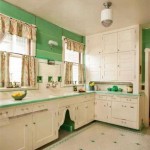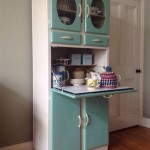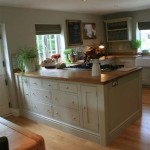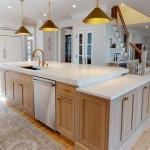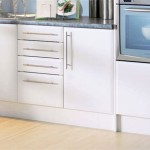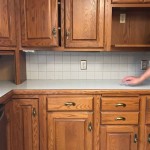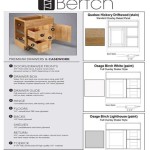How Can I Tell What Kind of Kitchen Cabinets I Have?
Determining the type of kitchen cabinets present in a space requires a systematic approach, considering several key characteristics that differentiate various cabinet styles and construction methods. A thorough assessment involves examining door styles, cabinet construction, materials used, and hardware details. This comprehensive evaluation helps in accurately identifying the existing cabinets, which is crucial for renovation projects, replacement considerations, and general understanding of the kitchen's design and value.
The identification process can be segmented into several distinct areas of focus. Initially, the style of the cabinet door itself provides significant clues. Next, analyzing how the cabinet box is constructed reveals information about the cabinet's quality and origin. Furthermore, the material used in both the door and cabinet box offers insights into the durability and aesthetic of the cabinets. Finally, examining the hardware, such as hinges and drawer slides, can provide clues regarding the age and potential manufacturer of the cabinets.
Examining Cabinet Door Styles
The most immediate and visually prominent aspect of a kitchen cabinet is the door style. Cabinet doors come in a wide array of designs, each reflecting different aesthetic preferences and historical periods. Identifying the door style is a foundational step in determining the overall type of cabinet.
Shaker Cabinets: Shaker cabinets are characterized by their simplicity and clean lines. They typically feature a five-piece flat panel door, consisting of a recessed center panel surrounded by a simple frame. This style emphasizes functionality and minimalism, making it a versatile choice that complements various kitchen designs, from traditional to contemporary. The Shaker style’s enduring popularity stems from its timeless appeal and ability to blend seamlessly with diverse decorative elements.
Flat-Panel Cabinets: Also known as slab-door cabinets, flat-panel cabinets offer a sleek and contemporary aesthetic. The doors are completely flat, without any ornamentation or detailing. This style is ideal for modern kitchens where a minimalist design is desired. The absence of grooves or frames makes flat-panel cabinets easy to clean and maintain, further enhancing their practicality.
Raised-Panel Cabinets: Raised-panel cabinets exhibit a more traditional and ornate design. The center panel of the door is raised, adding depth and dimension to the cabinet face. This style often incorporates intricate detailing, such as beveled edges and decorative molding. Raised-panel cabinets are commonly found in traditional or transitional kitchens, contributing to a classic and elegant ambiance.
Recessed-Panel Cabinets: Similar to Shaker cabinets, recessed-panel cabinets feature a recessed center panel. However, they may incorporate more elaborate detailing around the frame compared to the minimalist Shaker style. This style bridges the gap between Shaker and raised-panel cabinets, offering a balance of simplicity and ornamentation. The versatility of recessed-panel cabinets makes them suitable for various kitchen styles.
Glass-Front Cabinets: Glass-front cabinets feature glass panels in place of solid door panels, allowing the contents of the cabinet to be visible. This style is often used to display decorative items or to create a more open and airy feel in the kitchen. Glass-front cabinets can be paired with different frame styles, such as Shaker or raised-panel, to complement the overall kitchen design. Clear, frosted, or textured glass options provide further customization possibilities.
Beadboard Cabinets: Beadboard cabinets are characterized by vertical planks of wood with a small ridge or "bead" between each plank. This style adds texture and visual interest to the cabinet door, creating a rustic or farmhouse-inspired aesthetic. Beadboard cabinets are often painted in light colors to enhance their charm and are commonly found in country or cottage-style kitchens.
Analyzing Cabinet Box Construction
The construction method of the cabinet box provides valuable insights into the quality and durability of the cabinets. Two primary construction methods are typically encountered: framed and frameless.
Framed Cabinets: Framed cabinets feature a face frame, which is a wooden frame attached to the front of the cabinet box. The frame provides structural support and serves as an attachment point for the doors and drawers. Framed cabinets are known for their traditional appearance and sturdiness. The face frame extends beyond the cabinet box, creating a lip that can be visible when the doors are closed. This construction method is commonly found in American-style kitchens and offers a wide range of design possibilities.
Frameless Cabinets: Also known as European-style cabinets, frameless cabinets lack a face frame. The doors and drawers attach directly to the sides of the cabinet box. This construction method results in a clean, modern look with full access to the interior space. Frameless cabinets maximize storage capacity and are often favored in contemporary kitchens. The absence of a face frame allows for tighter reveals between doors and drawers, creating a seamless appearance.
In addition to the presence or absence of a frame, it is important to examine the materials used in the cabinet box construction. Common materials include plywood, particleboard, and medium-density fiberboard (MDF). Plywood is generally considered to be the most durable option, while particleboard is a more economical choice. MDF offers a smooth surface for painting and is less prone to warping than solid wood. The material used in the cabinet box construction significantly impacts the cabinet's longevity and resistance to moisture and wear.
Another factor to consider is the joinery method used to assemble the cabinet box. Common joinery methods include dovetail joints, dado joints, and screw construction. Dovetail joints are considered the strongest and most durable, while screw construction is a more economical option. The joinery method affects the cabinet's overall stability and resistance to racking. Inspecting the corners of the cabinet box can reveal the type of joinery used and provide insights into the cabinet's quality.
Identifying Materials Used
The materials used in the construction of both the cabinet doors and the cabinet box significantly influence the appearance, durability, and cost of the cabinets. Common materials include solid wood, wood veneer, laminate, and thermofoil.
Solid Wood Cabinets: Solid wood cabinets are constructed entirely from solid wood, providing a natural and luxurious look. Solid wood is durable and can be refinished or repainted, extending the lifespan of the cabinets. Common wood species used in cabinet construction include maple, oak, cherry, and walnut. The grain pattern and color of the wood contribute to the cabinet's unique character. Solid wood cabinets are typically more expensive than cabinets made from other materials.
Wood Veneer Cabinets: Wood veneer cabinets consist of a thin layer of real wood adhered to a substrate material, such as plywood or particleboard. This construction method offers the appearance of solid wood at a lower cost. Wood veneer cabinets can be stained or finished to match the desired aesthetic. The substrate material provides stability and prevents warping, while the wood veneer offers the natural beauty of solid wood. Veneer cabinets are a good option for achieving a high-end look without the expense of solid wood.
Laminate Cabinets: Laminate cabinets feature a decorative paper layer bonded to a substrate material. Laminate is available in a wide range of colors, patterns, and textures, offering versatile design possibilities. Laminate cabinets are durable, easy to clean, and resistant to scratches and stains. They are a cost-effective option for modern kitchens. Different grades of laminate offer varying levels of durability and resistance to wear.
Thermofoil Cabinets: Thermofoil cabinets are made by applying a thin layer of vinyl to a substrate material using heat and pressure. This process creates a seamless, durable finish that is resistant to moisture and stains. Thermofoil cabinets are available in a variety of colors and styles, offering a cost-effective alternative to painted wood cabinets. However, thermofoil cabinets are susceptible to damage from excessive heat, such as from ovens or dishwashers. Proper installation and maintenance are essential to ensure the longevity of thermofoil cabinets.
To determine the material of the cabinet doors and boxes, examine the edges and surfaces closely. Solid wood will have a consistent grain pattern throughout, while veneer will have a visible edge where the veneer is applied to the substrate. Laminate and thermofoil will have a smooth, uniform surface without any visible grain pattern. Examining the back of the cabinet doors and drawers can also provide clues about the material used.

How Do I Know If Have Laminate Cabinets Metropolitan Countertops

Can I Tell If Theril Kitchen Cabinets In My Home Rcd

The Best Kitchen Cabinet Types For Your Style And Budget

3 Diffe Types Of Kitchen Cabinets Pros Cons

Guide To Popular Kitchen Cabinet Styles Star Lumber

How Do You Tell If Your Cabinets Are Laminate Cabinetdoormart Com

Types Of Wood Used Making Kitchen Cabinets

About Two Tone Kitchen Cabinets Wolf Home S

Take This Quiz To Find Out How Many Kitchen Cabinets You Need

Top 13 Styles Of Kitchen Cabinets To Consider For The Hci
Related Posts

